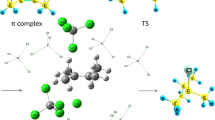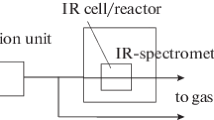Conclusion
The above developed ideas should not be regarded as criticism of the carbenium ionic conception in heterogeneous acid catalysis. They are aimed rather at its modernization.
We consider the present form of this theory as oversimplified. Owing to the absence of solvation effects, surface intermediates of high temperature catalytic conversions of hydrocarbons are of much less ionic character than it is usually believed. Therefore, the carbenium ionic properties are characteristic of transition states but not stable intermediates of these reactions.
Another feature of heterogeneous acid catalysis that is not usually taken into account is the bifunctional nature of its active sites. The acidic part protonates adsorbed molecules and the basic one either stabilizes intermediate structures or enables a reversible proton abstraction from transition states. In the case of substrates with a low proton affinity, this results in concerted mechanisms, where simultaneously with a proton transfer a new bond with the surface is formed. Deprotonation of intermediates in the case of catalytic transformations of hydrocarbons with a higher proton affinity supplies them with some features of adsorbed carbenes or ylides. This makes it possible to suggest new mechanisms of such acidic catalytic reactions as synthesis of hydrocarbons from methanol on high silica containing zeolites, olefin oligomerization, etc.
Similar content being viewed by others
References
G.K. Boreskov: Kinet. Katal.,11, 374 (1970)
G.K. Boreskov: Proc. of the All-Union Conference on the Mechanism of Heterogeneous Catalytic Reactions. Moscow, 1977, Chernogolovka, p. 3, 1977.
G.M. Zhidomirov, V.B. Kazansky: Advances in Catalysis,34, 131 (1987)
V.B. Kazansky, A.M. Gritztsov, V.M. Andreev, G.M. Zhidomirov: J. Mol. Catal.,3, 435 (1978)
V.B. Kazansky: Izvestiya po khimii BAN,13, 19 (1980)
V.B. Kazansky: Kinet. Katal.,21, 159 (1980)
“Energies of Chemical Bond Dissociation. Ionization Potentials and Electron Affinity”. Nauka, Moskva 1974.
I.D. Mikheikin, I.A. Abronin, G.M. Zhidomirov, V.B. Kazansky: J. Mol. Catal.,3, 935 (1978)
I.N. Senchenya, I.D. Mikheikin, G.M. Zhidomirov, V.B. Kazansky: Kinet. Katal.,23, 591 (1982)
I.N. Senchenya, N.D. Chuvilkin, V.B. Kazansky: Kinet. Katal.,26, 1073 (1985)
W.H. Flygare: “Molecular Structure and Dynamics”. Mir, Moskva 1982.
V.B. Kazansky, N.D. Chuvilkin: Dokl. Akad. Nauk SSSR,223, 910 (1979)
V.B. Kazansky, N.D. Chuvilkin, I.N. Senchenya: Kinet. Katal.,27, 1276 (1986)
N.D. Chuvilkin, V.A. Korsunov, V.B. Kazansky: Kinet. Katal.,27, 1323 (1986)
V.B. Kazansky: Kinet. Katal.,28, 47 (1987)
Author information
Authors and Affiliations
Rights and permissions
About this article
Cite this article
Kazansky, V.B. Concerted and stepwise mechanisms in heterogeneous acid catalysis. React Kinet Catal Lett 35, 237–248 (1987). https://doi.org/10.1007/BF02062160
Received:
Issue Date:
DOI: https://doi.org/10.1007/BF02062160




